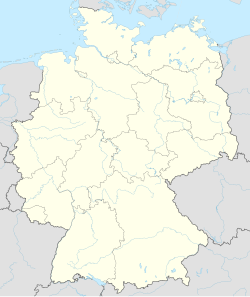센타우루스자리 E
E Centauri| 관측 데이터 Epoch J2000.0 이쿼녹스 J2000.0 | |
|---|---|
| 별자리 | 센타우루스 |
| 우측 상승 | 12h 08m 14.70518s[1] |
| 탈위임 | −48° 41′ 33.0323″[1] |
| 겉보기 크기 (V) | +5.34[2] |
| 특성. | |
| 스펙트럼형 | B9.5/A0V[3] |
| B-V색지수 | −0.010±0.007[2] |
| 아스트로메트리 | |
| 방사 속도 (Rv) | +7.2±0.5km[2]/s |
| 고유 운동 (μ) | RA: -27.271[1] mas/yr Dec.: -7.342[1] mas/yr |
| 시차 (π) | 5.8040 ± 0.2042[1] 마스 |
| 거리 | 560 ± 20 리 (105 ± 6 pc) |
| 절대치수 (MV) | −0.97[2] |
| 세부 사항 | |
| 미사 | 3.38±0.09[4] M☉ |
| 반지름 | 5.835[5] R☉ |
| 루미도 | 302+39 −35[4] L☉ |
| 표면 중력 (log g) | 3.16[5] cgs |
| 온도 | 9,886±69[4] K |
| 회전 속도 (v sin i) | 74km[4]/s |
| 기타 지정 | |
| 데이터베이스 참조 | |
| 심바드 | 자료 |
E 센타우리(E Centauri)는 센타우루스(Centaurus)의 남쪽 별자리에 있는 단일[7] 별이다.그것은 백색 띠로 육안으로 희미하게 보이는 항성으로, 겉으로 보이는 시각적 크기가 +5.34이다.[2]이 물체까지의 거리는 시차 기준 약 560광년이며, 절대 크기는 -0.97이다.[2]방사상 속도 +7km/s로 태양 가까이 표류하고 있으며,[2] Sco OB2 협회의 Lower Centaurus Crux 부분군의 후보 회원이다.[8]
이것은 후기 B형 또는 초기 A형 주계열성으로, 항성 분류는 B9.5/A0V로,[3] 코어 수소융합을 통해 에너지를 발생시키고 있음을 나타낸다.태양 질량의[4] 3.4배에 달하며 74km/s의 예상 회전 속도로 회전하고 있다.[4]이 별은 광구에서 태양의 302배인 광도를 유효 온도[4] 9886K로 방사하고 있다.[4]
참조
- ^ a b c d e Brown, A. G. A.; et al. (Gaia collaboration) (August 2018). "Gaia Data Release 2: Summary of the contents and survey properties". Astronomy & Astrophysics. 616. A1. arXiv:1804.09365. Bibcode:2018A&A...616A...1G. doi:10.1051/0004-6361/201833051.이 소스에 대한 가이아 DR2 기록 VizieR.
- ^ a b c d e f g Anderson, E.; Francis, Ch. (2012), "XHIP: An extended hipparcos compilation", Astronomy Letters, 38 (5): 331, arXiv:1108.4971, Bibcode:2012AstL...38..331A, doi:10.1134/S1063773712050015, S2CID 119257644.
- ^ a b Houk, Nancy (1978), Michigan catalogue of two-dimensional spectral types for the HD stars, vol. 2, Ann Arbor: Dept. of Astronomy, University of Michigan, Bibcode:1978mcts.book.....H.
- ^ a b c d e f g h Zorec, J.; Royer, F. (2012), "Rotational velocities of A-type stars. IV. Evolution of rotational velocities", Astronomy & Astrophysics, 537: A120, arXiv:1201.2052, Bibcode:2012A&A...537A.120Z, doi:10.1051/0004-6361/201117691, S2CID 55586789.
- ^ a b McDonald, I.; Zijlstra, A. A.; Watson, R. A. (2017), "Fundamental parameters and infrared excesses of Tycho-Gaia stars", Monthly Notices of the Royal Astronomical Society, 471 (1): 770, arXiv:1706.02208, Bibcode:2017MNRAS.471..770M, doi:10.1093/mnras/stx1433.
- ^ "E Cen". SIMBAD. Centre de données astronomiques de Strasbourg. Retrieved 2020-03-03.
- ^ Eggleton, P. P.; Tokovinin, A. A. (September 2008), "A catalogue of multiplicity among bright stellar systems", Monthly Notices of the Royal Astronomical Society, 389 (2): 869–879, arXiv:0806.2878, Bibcode:2008MNRAS.389..869E, doi:10.1111/j.1365-2966.2008.13596.x, S2CID 14878976.
- ^ Hoogerwerf, Ronnie (March 2000), "OB association members in the ACT and TRC catalogues", Monthly Notices of the Royal Astronomical Society, 313 (1): 43–65, Bibcode:2000MNRAS.313...43H, doi:10.1046/j.1365-8711.2000.03192.x.


